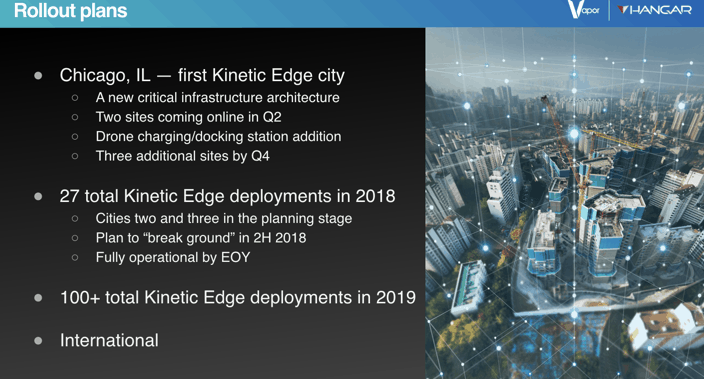In light of the recent setbacks experienced over the past week for autonomous vehicles—most notably the death of a pedestrian in Tempe from an Uber Volvo, and another Tesla Model X fatality on a southern California highway—industry experts and innovators, as well as regulators, are asking just how fast autonomous will reach our roads. For all the hype, are autonomous further away than we’re preparing for, like 2025 rather than 2020?
Some argue that infrastructure for “smart cities” needs to develop before autonomous vehicles. So, when Vapor IO and Hangar announced a partnership yesterday to bring autonomous drones to the “Kinetic Edge,” first in Chicago, and then five other cities by the end of 2019 (the companies are targeting a full 30 cities by 2020), FreightWaves reached out to learn more. FreightWaves spoke with Matt Trifiro, CMO of Vapor IO, by email to get a little more information on what the companies are up to.
So what’s stopping autonomous cars from coming first? It’s about the interconnected power of the infrastructure, but it’s also simply about the challenge for autonomous vehicles of all kinds. “The cost, size, complexity and power consumption of the supercomputers and sensors on each car are the main factors preventing today’s autonomous cars from scaling,” writes Trifiro.
“Indeed, autonomous cars will need some way of behaving reasonably when not connected to the grid. However, as the grid becomes more powerful, it will augment the onboard computers with real-time decision support, task offloading, and connection to other data streams and sensor networks (e.g., how else will the car “see” around corners?)”
The Kinetic Edge is a technical architecture for edge computing that can span a metropolitan region. Project Volutus, a partnership with Crown Castle, Packet, Intel and the Open19 Foundation, seeks to build Kinetic Edge cities across the US by embedding thousands of carefully-situated micro data centers into the wireless infrastructure, including co-locating at cell towers and aggregation hubs, allowing for high-powered servers and storage devices to be placed one hop away from the wireless network.
“The tens of thousands of autonomous robots being deployed by public and private organizations will require a national edge infrastructure,” said Jeff DeCoux, founder and CEO of Hangar in a statement.
Cars, trucks, buses and other forms of ground transportation operate atop a rich platform of highways, lights, signs and rules of the road, all of which are designed for human drivers. Were it not for this immensely capable shared infrastructure, available for all of us to use, we would not have the mobility we do today—or its economic benefit.
“The cost, size, complexity and power consumption of the supercomputers and sensors on each car are the main factors preventing today’s autonomous cars from scaling.”
“We don’t need to build roads; we don’t need to install traffic lights; we don’t need traffic signs,” they write. “We need infrastructure for software, data and communications. This drone infrastructure will program the drone flights, provide real-time data feeds for traffic management, decision-support, emergency response, and other capabilities.”
Just like the national highway system, this infrastructure will need to be shared. For one thing, it’s simply too expensive for every drone operator to purchase or lease their own real estate for edge compute and build their own data centers, let alone strike relationships with the municipalities and the key wireless service providers. Only with shared infrastructure can each operator leverage the precise navigation, micro-weather, traffic management and other critical services that make autonomous drones possible.
This is why Vapor and Hangar are building an open platform that will support many ecosystem participants, including data providers, software services, government regulators and the autonomous robotics companies themselves.

By spreading micro data centers across a metropolitan region and connecting them with high speed fiber and software, the Kinetic Edge becomes a perfect platform for deploying automated robotics at city-scale. Not only do the edge locations offer highly-secure, geographically dispersed “homes” for the drones, where they can recharge and offload data, the edge locations can also house all of the key infrastructural components for autonomous drones, including the hardware and software for precision-navigation, traffic management, and micro-weather delivery that will enable thousands of drones to fly in dense urban environments without human intervention.
Drone technology will advance more quickly than autonomous, according to Trifiro because of “fewer life safety issues,” for starters. “It’s also a lot less complicated to navigate in coordinated airspace than to drive on a road that has all kinds of obstacles, road signs, rules, and so on, including other unpredictable humans,” he writes. “Finally, the drone industry is embracing edge computing, which will provide greater levels of coordination than isolated vehicles on the ground.”
Each micro data center can house a minimum of 165kW of IT gear, which is over 10,000 cores. “That’s a lot of compute,” writes Trifiro.
“Our Kinetic Edge module calls for 3 or more micro data centers in a region, each separated by about 15Km and connected with multiple redundant fiber paths. This provides a nice balance between latency and coverage. That said, we can pack these things as densely as required, provided there is sufficient physical space (e.g., cell tower locations).”
What may come as a surprise is who is paying for all this data assimilation.
“We don’t require municipalities to pay at all. The rollout is funded by Vapor IO, Hangar, Crown Castle and other partners. The installation cost is amortized over many years and Vapor IO is in the business of leasing capacity in its micro data centers in order to recoup the capital investment as well as ongoing profit,” Trifiro explains.
Trifiro says the company will roll out first in Chicago, where they have the first two sites operational. “We will be at 5 sites in Chicago by EOY.”

Stay up-to-date with the latest commentary and insights on FreightTech and the impact to the markets by subscribing.










